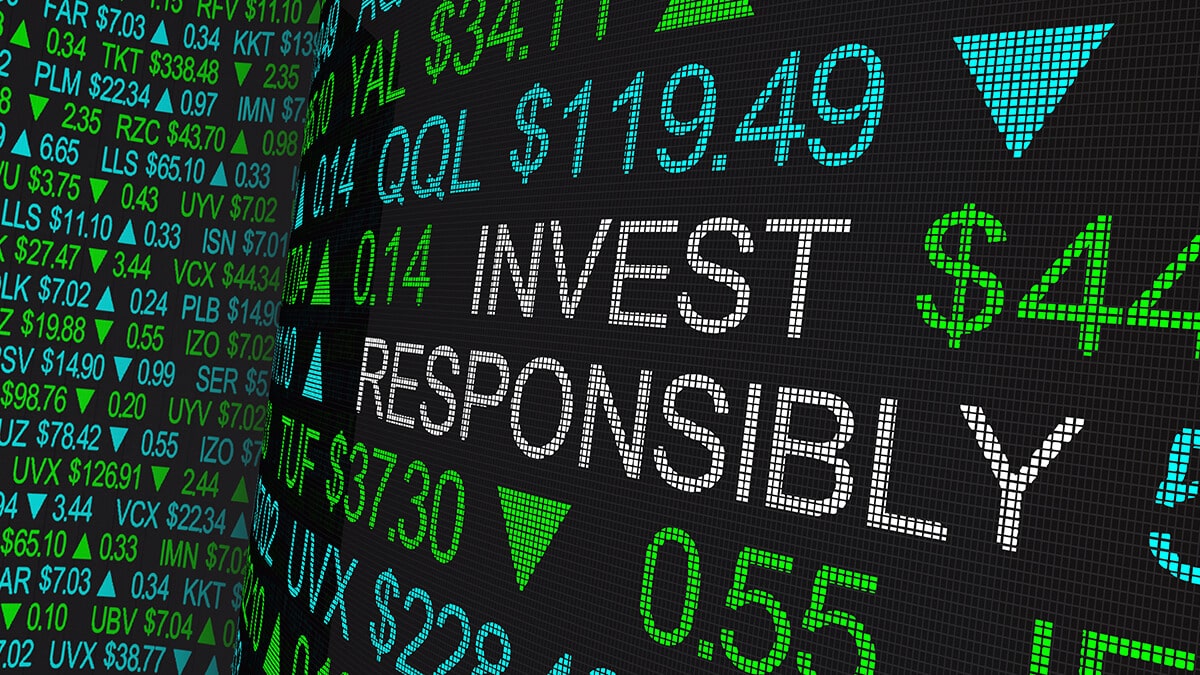In this guide
Although you might want your super fund to be a top performer, for many fund members it’s also increasingly important that their money is invested responsibly and in line with their personal values.
Thankfully, investing with a conscience doesn’t mean sacrificing returns (see Why are super funds using RI approaches below).
According to the report From Value to Riches 2022: Charting consumer demand for responsible investing in Australia by the Responsible Investment Association Australasia (RIAA), awareness of, and demand for, responsible and ethical investments is growing strongly and is now a mainstream issue. The study found the proportion of Australians with responsible investments has hit 17%, driven largely by Gen Xers and Millennials. Four out of five people now expect both their super and bank accounts to be invested responsibly and ethically, and 80% also expect their savings to have a positive impact on the world.
Super funds are responding to this desire, with many now offering members the opportunity to switch their super into a responsible investment (RI) option. If you feel uncomfortable with your retirement savings supporting activities like fossil fuel mining, armaments development or exploitation of employees in third-world countries, it might be time to check out these investment options.
How does responsible investing work?
Responsible investing is now playing a significant role in global investment markets. In Australia, the RIAA’s 2023 Benchmark Report found $1.3 trillion in assets was invested using these approaches at the end of 2022. This represented 36% of the market, despite a challenging 2022 that saw the inability of the responsible market to capitalise on the success of the mining sector drag down returns versus mainstream funds.
In the investment world, responsible investing takes into account environmental, social, governance (ESG) and sometimes ethical issues as a part of the investment process. Large investors now recognise these issues can represent key non-financial risks that can affect the future performance of an investment.

Free eBook
Retirement planning for beginners
Our easy-to-follow guide walks you through the fundamentals, giving you the confidence to start your own retirement plans.
"*" indicates required fields
Considering these issues when selecting and owning an investment asset means looking at how the company or investment asset deals with:
- Environmental issues (such as pollution, climate change, water or other resource scarcity)
- Social issues (such as involvement in local communities, their employees, health and safety)
- Corporate governance issues (such as business ethics, strong boards and appropriate executive pay)
Responsible investing covers a wide variety of definitions, approaches and strategies. At its core, it is about trying to minimise harm through investing or delivering social benefit aside from the benefit to the investor.
The RIAA breaks it down into a responsible investment spectrum with seven essential categories:
- ESG Integration: Consideration of ESG factors as part of investment decisions. Rather than specifically targeting responsible investment, this approach is financially focused. It considers how ESG factors could positively or negatively impact investment returns
- Corporate Engagement/Shareholder Action: Using shareholder power to influence corporate behaviour by exercising the right to vote at shareholder meetings
- Negative Screening: Industry sectors or companies excluded/divested to avoid risk and better align with values
- Norms-based Screening: Screening out investments that do not meet minimum standards, and including investments that meet defined ESG standards
- Positive/Best-in-class Screening: Investments that target companies or industries with better ESG performance
- Sustainability-themed Investment: Investments that specifically target sustainability themes, for example, clean energy and green property
- Impact Investing and Community Investing: Investments that target positive social and environmental impact.
Source: RIAA
These approaches are loosely listed from least to most focus on sustainability and ethical factors when selecting investments. Why are super funds using RI approaches?
Super funds are considering RI issues when they select assets for their investment portfolio because there is strong evidence this strategy enhances a fund’s long-term investment performance and reduces the non-financial risks it faces. The necessity of considering ESG factors to achieve the best financial outcomes has become so clear that the Australian Prudential Regulation Authority (APRA) now requires all super funds to demonstrate an understanding of the risks and opportunities present in a range of ESG factors and provide evidence of how they are integrated into investment analysis, decision making and oversight. These are requirements of updated standards on investment governance introduced in July 2023.
This is reflected in the RIAA’s 2023 Benchmark Report, which found responsible investment products outperformed the overall managed fund market in the managed growth, international shares and Australian shares categories over 3, 5 and 10 years. Responsible funds underperformed over one year (2022) because the mining sector, avoided by many responsible funds, performed strongly and contributed to high returns of mainstream funds.
Choosing a RI investment option
While all super funds are required to consider ESG factors, some fund members want to go further and ensure none of the money in their super account is in an investment option that doesn’t completely align with their values.
2026 SMSF calendar
Our free calendar includes due dates for important documents plus suggested dates for trustee meetings and other strategic issues for your SMSF.
"*" indicates required fields
In fact, the RIAA From Values to Riches 2022 Report found 74% of Australians would consider moving to another provider if they found out their current fund was investing in companies engaged in activities not consistent with their values.
To cater to this growing demand, many super funds offer sustainable or responsible investment options to their members. These options have a wide variety of names such as ethical, responsible, socially aware, or sustainable.
If you have your own self-managed super fund (SMSF) you may of course choose your own investments directly, ensuring that they align with your values. For a less hands-on approach you could consider an ethical exchange-traded fund (ETF) or get help from a financial adviser who is a member of the Ethical Advisers’ Co-op.
3 things to consider when choosing a RI or sustainable investment option
If you’re interested in having your super savings invested according to sustainable or RI considerations, you need to ask yourself three questions:
1. What issues are important to me?
Think about the activities or issues that matter to you, as everyone will have a different view.
What activities must your super fund consider when selecting assets for its investment option? For example, does gambling, logging or animal cruelty matter to me?
As different super funds use different criteria in their screening processes, you need to decide your own personal lines in the sand.
You can also consider how much focus you want your fund to place on environmental or ethical factors. Are you happy to simply screen out companies with the most negative impact, or do you want an option that incorporates only investments with a positive impact?
Super knowledge is a super power

"*" indicates required fields
3. Does my super fund offer an ethical or RI investment option?
Although some super funds offer clearly labelled sustainable, socially responsible or ethical investment options, other super funds have taken a different path. Instead, they have chosen to invest all the fund’s assets using a RI approach. In this case, your super funds may not offer a clearly labelled RI or sustainable investment option.
If your fund offers a RI option, you should do some homework prior to switching. Ensure you read all the information provided about the businesses and/or investment activities it invests in, plus the research and screening process it undertakes prior to selecting assets. This will help you understand whether it addresses the issues you’re concerned about.
Not all screens are equal, so make sure you read the fine print. For example, your fund may say they screen out companies involved in tobacco, while the screen permits investment in organisations that derive up to 10% of their profits from tobacco production. This means the fund wouldn’t invest in a company like British American Tobacco, where cigarettes are core business, but could invest in other organisations that play a supporting role along with conducting activities in other industries.
Investigate the investment methods used by your fund to see if they match your expectations. Are you satisfied with using investment screens, or do you want a sustainability themed or impact investment?
3. Do I want a broad or a specific asset class RI option?
Within their RI or sustainable investment options, some super funds offer members a further choice of specific asset class or specific investment style, such as Ethical High Growth, Ethical Balanced or Australian Shares Socially Responsible Investment option.
Switching your super account to a new investment option
Once you have decided on an investment option that matches your values, you will need to switch over to that option if it is within your current super fund.
If there is not a suitable investment option in your current super fund, the Ethical Advisers’ Co-op offers public access to their ratings of super funds that do offer ethical options. The leaf rating tells you at a glance the fund’s rating out of 5, and you can read the detailed report on each fund to find out more. The rating relates only to ethical credentials – not fees, performance or financial suitability.
How do you find out what your super fund invests in?
Since 2021, super funds have been required to provide on their website a detailed list of the assets held in each of their investment options. This must be updated twice a year. Search your fund’s website for ‘portfolio holdings disclosure’ to find it.
Make your super work harder – for free

Get practical, independent guidance to help you grow your balance, save tax and make smarter super decisions with a free SuperGuide account.
Find out moreAnother way to get an insight into what super funds are doing is to check the RIAA’s certification program. The program audits the asset holdings and management processes used by super funds and investment managers to ensure they are doing what they claim in their sustainability and RI marketing materials. For more information, visit the RIAA website.
Which funds are leading the way on climate change?
While many super funds have targets to achieve net zero emissions by 2050 for their investment portfolios, in practice the industry’s investment in fossil fuel remains significant.
We investigated the ten largest publicly available super funds and found all have committed to a net zero target by 2050, with Aware Super, UniSuper and Mercer Super making further statements on target reductions by 2030.
If you want to exclude fossil fuels from your super portfolio now it is possible, but the variety of options is small.
Australian Ethical, Australian Retirement Trust, Aware Super, Catholic Super, Cruelty Free Super, Future Super, HESTA, REST, UniSuper and Verve all have options that exclude coal, oil and gas, and have no exposure to the 190 companies on the ‘climate wreckers index’ according to market forces, an organisation set up to expose institutions financing environmentally destructive projects.
You can find an updated list of super funds and their approach to excluding fossil fuels here.



Leave a Reply
You must be logged in to post a comment.